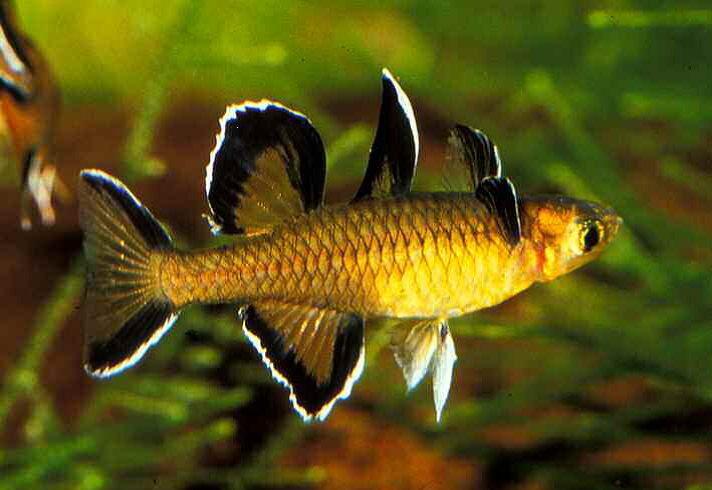Honey Blue Eye, Pseudomugil mellis Allen & Ivantsoff 1982

A male Honey Blue Eye, Pseudomugil mellis, in an aquarium. Source: Neil Armstrong. License: All rights reserved
Video of Honey Blue Eyes in an aquarium.
Honey Blue Eye courting behaviour.
Honey Blue Eyes in an aquarium.
Honey Blue Eye, Pseudomugil mellis Allen & Ivantsoff 1982
More Info
|
Distribution |
Endemic to south-eastern Queensland, from the upper reaches of Water Park Creek, northeast of Rockhampton, coastal streams from southeast of Maryborough to north of Caboolture, and Fraser Island. Inhabits slow-flowing, tannin-stained freshwater creeks and coastal dune lakes with sandy or muddy bottoms. Often found amongst aquatic vegetation along grassy banks. |
|
Features |
Dorsal fin IV-VI1; 6-9; Anal fin 10-13; Pectoral fin 9-12; Pelvic fin 5; Caudal fin 13-14; Gill rakers 10-13; Vertebrae 28-31 Body relatively elongate, laterally compressed; greatest body depth 19.2-29.4% SL; mouth small with a protractile maxillary; jaw teeth conical to villiform, with or without one or more rows extending outside of mouth; vomer and palatines toothless; eye relatively large; some small pores on head but absent on mandibular. Scales relatively large, cycloid with well-developed radii; cheek scales 3-4; vertical scale rows 26-29; horizontal scale rows 5-6; predorsal scales 8-12. Two separate dorsal fins; first dorsal fin originating before tip of pectoral about midway along body; second dorsal fin originates behind anal fin origin; anal fin originating under end or just behind first dorsal and in front of second dorsal origin; dorsal and anal fins lack rigid spines; pectoral fins short, pointed and set in a horizontal plane; caudal fin forked with rounded tips; mature males with elongate anterior dorsal, anal and ventral fin rays. |
|
Size |
To 3.5 cm SL. |
|
Colour |
Although males and females differ in colouration, both have a blue eye and fine grainy melanophores on the head. Males are generally honey or bronze coloured; first dorsal fin mainly black with white anterior border; anal and second dorsal fins honey coloured with black submarginal band and white border. Females are plain amber colour with clear fins. Juveniles are greyish. |
|
Feeding |
Feeds mainly on micro-crustaceans and insect larvae. |
|
Biology |
Breeds opportunistically throughout the year. Males display to females by intensifying their colours and erecting their ornate fins. Breeding episodes last several days with females depositing 4-10 adhesive eggs per day amongst aquatic vegetation. Larvae hatch in 2-3 weeks. |
|
Fisheries |
A popular aquarium fish that is mostly bred in captivity. |
|
Conservation |
IUCN Red List: Endangered |
|
Remarks |
Males differ from females in having brighter colouration and more elongated dorsal fins. The rapid decline in numbers of this species may be linked to the removal of suitable habitat for housing developments. |
|
Similar Species |
Differs from the similar Pacific Blue Eye, Pseudomugil signifier, in having smaller scales on the nape, smaller cephalic sensory pores, and the dorsal, anal and caudal fins of males have a broad black submarginal band with a narrow white margin (vs. yellowish fins with a black margin). |
|
Etymology |
The specific name is from the Latin mellis (= honey), in reference to the body colour of this species. |
|
Species Citation |
Pseudomugil mellis Allen & Ivantsoff, 1982, Rev. Fr. Aquariol. 9(3): 83. Type locality: Marsh near Peregian Beach, about 10 km south of Noosa Head, Queensland, Australia, about 26°29'S, 153°05'E. |
|
Author |
Thompson, V.J. & Bray, D.J. 2024 |
|
Resources |
Honey Blue Eye, Pseudomugil mellis Allen & Ivantsoff 1982
References
Allen, G.R. 1989. Freshwater Fishes of Australia. Neptune, New Jersey : T.F.H. Publications, 240 pp.
Allen, G.R. & Ivantsoff, W. 1982. Pseudomugil mellis, le honey Blue-eye, une nouvelle espèce de poisson Arc-en-ciel (Melanotaeniidae) d'Australie orientale. Revue française d'Aquariologie Herpétologie 9(3): 83–86 figs 1–7
Allen, G.R., Midgley, S.H. & Allen, M. 2002. Field guide to the freshwater fishes of Australia. Perth : Western Australian Museum 394 pp.
Arthington, A.H. & Marshall, C.J. 1993. Volume 1: Distribution, ecology and conservation of the Honey Blue-eye, Pseudomugil mellis, in south-eastern Queensland. Final Report to the Australian Nature Conservation Agency, Canberra. 100 pp.
Arthington, A.H. & Marshall, C.J. 1995. Threatened fishes of the world: Pseudomugil mellis Allen & Ivantsoff, 1982 (Pseudomugilidae). Environmental Biology of Fishes 43: 268.
Brooks, S. & Arthington, A. 2019. Pseudomugil mellis. The IUCN Red List of Threatened Species 2019: e.T18543A123378987. https://dx.doi.org/10.2305/IUCN.UK.2019-3.RLTS.T18543A123378987.en. Accessed on 14 July 2022.
Howe, E. 1987. Breeding behaviour, egg surface morphology and embryonic development in four Australian species of the genus Pseudomugil (Pisces: Melanotaenidae). Australian Journal of Marine and Freshwater Research 38: 885-895
Leggett, R. & Merrick, J.R. 1987. Australian Native Fishes for Aquariums. Artarmon : J.R. Merrick Publications 241 pp. 142 figs.
Pusey B., Kennard M. & Arthington A. 2004. Freshwater fishes of north-eastern Australia. CSIRO publishing, Collingwood, Victoria 684 pp.
Saeed, B., Ivantsoff, W. & Allen, G.R. 1989. Taxonomic revision of the family Pseudomugilidae (Order Atheriniformes). Australian Journal of Marine and Freshwater Research 40: 719–787
Semple, G.P. 1991. Reproductive Behaviour and early Development of the Honey Blue-eye, Pseudomugil mellis Allen and Ivantsoff 1982 (Pisces: Pseudomugilidae), from the North-east Coast Division, South-eastern Queensland, Australia. Australian Journal of Marine and Freshwater Research 42: 277-286.
Wong, B.B.M., Keogh, J.S. & Glashan, D.J.M. 2004. Current and historical patterns of drainage connectivity in eastern Australia inferred from population genetic structuring in a widespread freshwater fish Pseudomugil signifier (Pseudomugilidae). Molecular Ecology 13: 391–401



